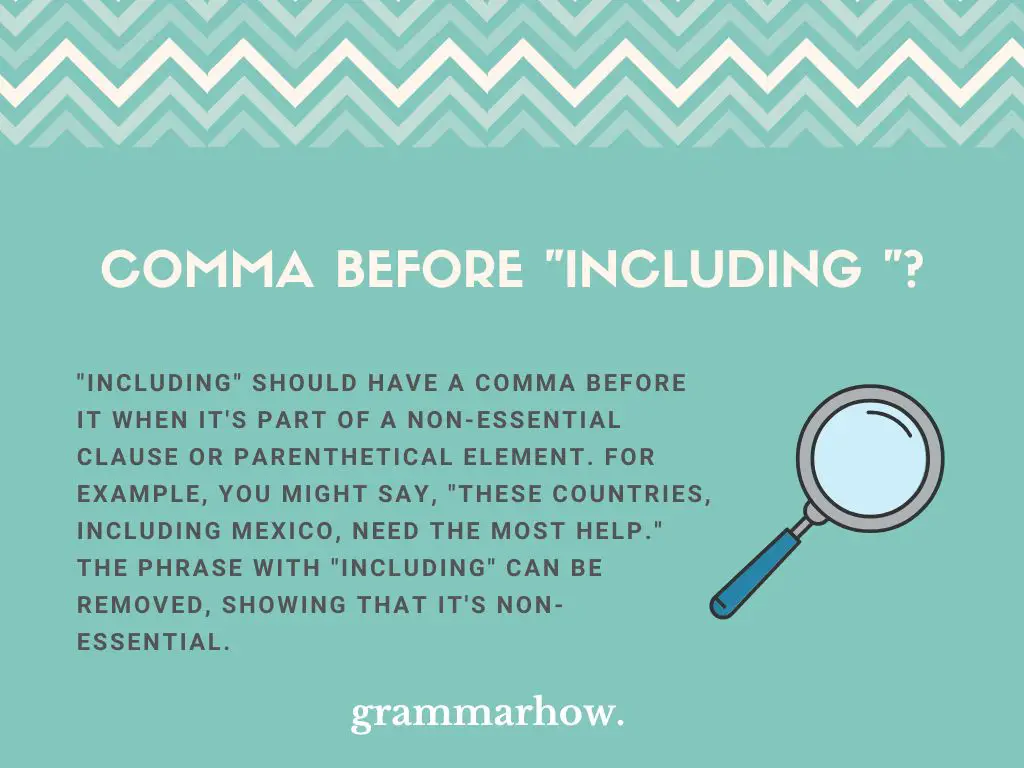“Including” is a surprisingly difficult word to punctuate correctly. It’s a preposition and a verb, depending on how you use it. This can lead to difficulty understanding the comma rules. This article will explore all you need to know when punctuating “including.”
Comma Before “Including “?
“Including” should have a comma before it when it’s part of a non-essential clause or parenthetical element. For example, you might say, “these countries, including Mexico, need the most help.” The phrase with “including” can be removed, showing that it’s non-essential.

KEY TAKEAWAYS
- “Including” rarely requires a comma.
- You should only include a comma before “including” when it is the first word of a non-essential clause, e.g. “this, including that, is correct.”
Here are a few more examples to demonstrate how this works:
- Matt’s friends, including Billy, decided playing a few pranks on him would be fun.
- The cities, including Chicago, all elected to vote on the new protocols.
“Including” is part of a non-essential phrase in both examples. You may remove it, and the sentence will still make sense. For example:
- Matt’s friends decided playing a few pranks on him would be fun.
This is the most likely time when a comma comes before “including.”
The Chicago Manual of Style and the AP Stylebook both explain that commas are treated like parentheses. This means you may use them to include additional information in a sentence. You do not have to include the information (and it can be removed).
When to Place a Comma Before “Including”
There aren’t many situations where commas work with “including.” Once you know the main situations, you’ll know all of them.
A comma comes before “including” when it is the first word of a non-essential clause. The easiest way to test whether a clause is non-essential is by removing it from a sentence.
- The people, including my mother and father, were going to watch.
- The people were going to watch.
Here, you can see that “including” is non-essential to the sentence. A comma comes before it to offset the non-essential clause before going into more detail.
When to Use “Including” Without a Comma
“Including” is most commonly seen without a comma. It is a verb in most cases, meaning you do not need to use a comma because it demonstrates the action of “including” something.
In most sentences, “including” is an action. You can use it in the following ways without punctuation:
- I wrote those including but not limited to the rest of the products as well.
- We were including everybody in our games, but we don’t want to do that anymore.
- Including Jackie was a mistake. We’re so sorry we put you through that.
You might also find that “including” is part of a restrictive clause. This is similar to a non-essential clause because it’s not a complete sentence. However, it does not get any commas around it because it “restricts” the rest of the sentence from being correct on its own.
Here’s what a restrictive clause with “including” looks like:
- I only eat meals including burgers.
Here, “including burgers” is used to show that you only eat specific types of meals. You do not need a comma before “including” because it is not a non-essential clause. If you remove “including burgers,” the sentence makes very little sense.
- I only eat meals.
This is the easiest test to see whether “including” is non-essential or restrictive. Remove the phrase starting at “including” to find out whether a comma is needed.
Comma After “Including”?
There is never a time when a comma should come after “including.” “Including” comes with two main uses: a preposition or a verb. Neither situation requires a comma after it because “including” is supposed to continue into more information.
You may not include a comma after “including” before a list, even though some people have a habit of doing this:
- Correct: The singers, including Miley Cyrus and Billie Eilish, were all there.
- Incorrect: My friends, including, Matt, Joseph, and Clark, knew I was going to be with them.
Including a comma after “including” makes no sense here. You should avoid doing it because it creates a jarring pause in the sentence structure.

Martin holds a Master’s degree in Finance and International Business. He has six years of experience in professional communication with clients, executives, and colleagues. Furthermore, he has teaching experience from Aarhus University. Martin has been featured as an expert in communication and teaching on Forbes and Shopify. Read more about Martin here.
